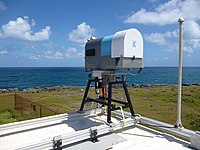
Photo from wikipedia
This article presents the first detailed description of the innovative measurement setup of an indoor tropospheric microwave radiometer [TROpospheric WAter RAdiometer (TROWARA)] that avoids water films on radome. We discuss… Click to show full abstract
This article presents the first detailed description of the innovative measurement setup of an indoor tropospheric microwave radiometer [TROpospheric WAter RAdiometer (TROWARA)] that avoids water films on radome. We discuss the performance of a commercial outdoor microwave radiometer [Humidity And Temperature PROfiler radiometer (HATPRO)] for measuring tropospheric water parameters in Bern, Switzerland. The HATPRO is less than 20 m from the TROWARA and has different instrument characteristics. Brightness temperatures measured by HATPRO are analyzed by comparing them with coincident measurements from TROWARA and Radiative Transfer Simulations based on the [European Centre for Medium-Range Weather Forecasts (ECMWF)] operational analysis data (denoted as RTSE). To find the source of brightness temperature bias, a gradient boosting decision tree is used to analyze the sensitivity of eight feature factors to bias. Data processing routines of the two radiometers use different algorithms to retrieve integrated water vapor (IWV) and integrated cloud liquid water (ILW), whereas the same physical algorithms based on the radiative transfer equation are applied to obtain the opacity and rain rate. Using 62 days of data with varied weather conditions, it was found that TROWARA brightness temperatures are in good agreement with RTSE. HATPRO brightness temperatures are significantly overestimated by about 5 K at 22 GHz, compared to TROWARA and RTSE. HATPRO brightness temperatures at 31 GHz agree well with TROWARA and RTSE (within about ±1 K). The overestimated brightness temperatures in the K-band and the HATPRO retrieval algorithm lead to an overestimation of IWV and ILW by HATPRO. The opacities at 31 GHz match very well for TROWARA and HATPRO during no rain with a verified $R^{2}$ of 0.96. However, liquid water floating or remaining water films on the radome of the outdoor HATPRO radiometer induce an overestimation of the rain rate. The physical reason for the overestimated 22-GHz brightness temperatures of the HATPRO is mainly the result of the combined effect of instrument calibration, the surrounding environment of the instrument, and the Sun elevation angle. This can be a problem with the Generation 2 HATPRO radiometer and this problem was resolved in the Generation 5 HATPRO radiometer.
Journal Title: IEEE Transactions on Geoscience and Remote Sensing
Year Published: 2023
Link to full text (if available)
Share on Social Media: Sign Up to like & get
recommendations!